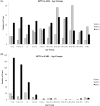A 28-year study of human parainfluenza in Rio Grande do Sul, Southern Brazil
- PMID: 30866089
- PMCID: PMC7166594
- DOI: 10.1002/jmv.25459
A 28-year study of human parainfluenza in Rio Grande do Sul, Southern Brazil
Abstract
Problem: Human parainfluenza virus (hPIV) is an important pathogen in respiratory infections, however the health burden of hPIV is underestimated. This study describes the infections by hPIV1-3 in Rio Grande do Sul, Brazil, from 1990 to 2017, providing data of the frequency and seasonality of cases and associated clinical symptoms.
Method of study: Nasopharyngeal samples of patients with respiratory infection were collected, clinical data were analyzed, and immunofluorescence was used to detect hPIV.
Results: Respiratory viruses were detected in 33.63% of respiratory infections. In a total of 11 606 cases of viral respiratory infection, 781 were positive for hPIV; hPIV prevalence ranged from 2.14% to 27% of viral respiratory infections. hPIV1 circulates mainly during fall; hPIV3 circulation, in turn, starts in fall and peaks during spring; and cases of hPIV2 are reported along the year, with peaks in fall and early spring. The most affected age group was children, with hPIV prevalence of 74.23% in patients for less than 1 year. A higher proportion of girls were infected than boys, however, no difference by sex was observed considering all age groups. The most frequent type was hPIV3, especially in hospitalized patients. Both hPIV1 and 3 were associated with dyspnea, while hPIV2 caused mild symptoms mainly in nonhospitalized patients. Nineteen fatalities occurred, 89.5% of them associated with risk factors (prematurity; chronic diseases; age, <1 or >60 years).
Conclusion: hPIV causes a high number of respiratory infections, leading to hospitalization especially in children; epidemiological and surveillance studies are important for the control and management of respiratory infections.
Keywords: acute respiratory infection; hPIV infection; respiratory virus; severe acute respiratory infection.
© 2019 Wiley Periodicals, Inc.
Conflict of interest statement
The authors declare that there are no conflict of interests.
Figures



Similar articles
-
Clinical and epidemiological characteristics of human parainfluenza virus infections of children in southern Taiwan.J Microbiol Immunol Infect. 2018 Dec;51(6):749-755. doi: 10.1016/j.jmii.2016.08.017. Epub 2017 Jun 22. J Microbiol Immunol Infect. 2018. PMID: 28757139
-
Characteristics of human parainfluenza virus type 4 infection in hospitalized children in Korea.Pediatr Int. 2020 Jan;62(1):52-58. doi: 10.1111/ped.14049. Epub 2020 Jan 19. Pediatr Int. 2020. PMID: 31705838 Free PMC article.
-
Human parainfluenza virus types 1-4 in hospitalized children with acute lower respiratory infections in China.J Med Virol. 2016 Dec;88(12):2085-2091. doi: 10.1002/jmv.24580. Epub 2016 May 30. J Med Virol. 2016. PMID: 27197630 Free PMC article.
-
Global burden of acute lower respiratory infection associated with human parainfluenza virus in children younger than 5 years for 2018: a systematic review and meta-analysis.Lancet Glob Health. 2021 Aug;9(8):e1077-e1087. doi: 10.1016/S2214-109X(21)00218-7. Epub 2021 Jun 21. Lancet Glob Health. 2021. PMID: 34166626 Free PMC article.
-
The landscape of extrapulmonary manifestations of human parainfluenza viruses: A systematic narrative review.Microbiol Immunol. 2021 Jan;65(1):1-9. doi: 10.1111/1348-0421.12865. Epub 2020 Dec 31. Microbiol Immunol. 2021. PMID: 33270253
Cited by
-
Epidemiological Characteristics of Human Parainfluenza Viruses Infections - China, 2019-2023.China CDC Wkly. 2024 Mar 22;6(12):235-241. doi: 10.46234/ccdcw2024.047. China CDC Wkly. 2024. PMID: 38633430 Free PMC article.
-
Epidemiological Characteristics of Parainfluenza Virus Type 3 and the Effects of Meteorological Factors in Hospitalized Children With Lower Respiratory Tract Infection.Front Pediatr. 2022 Apr 27;10:872199. doi: 10.3389/fped.2022.872199. eCollection 2022. Front Pediatr. 2022. PMID: 35573951 Free PMC article.
-
Unveiling viral pathogens in acute respiratory disease: Insights from viral metagenomics in patients from the State of Alagoas, Brazil.PLoS Negl Trop Dis. 2024 Sep 23;18(9):e0012536. doi: 10.1371/journal.pntd.0012536. eCollection 2024 Sep. PLoS Negl Trop Dis. 2024. PMID: 39312587 Free PMC article.
-
Epidemiological, Clinical, and Genomic Traits of PIV in Hospitalized Children After the COVID-19 Pandemic in Wuhan, China.J Med Virol. 2024 Dec;96(12):e70117. doi: 10.1002/jmv.70117. J Med Virol. 2024. PMID: 39673291 Free PMC article.
-
Study of the Etiology of Acute Respiratory Infections in Children Under 5 Years at the Dr. Agostinho Neto Hospital, Praia, Santiago Island, Cabo Verde.Front Pediatr. 2021 Sep 28;9:716351. doi: 10.3389/fped.2021.716351. eCollection 2021. Front Pediatr. 2021. PMID: 34650939 Free PMC article.
References
MeSH terms
LinkOut - more resources
Full Text Sources
Research Materials

